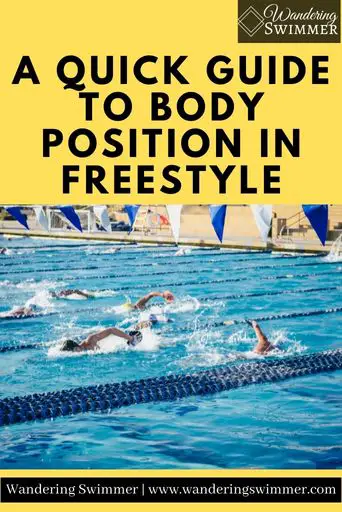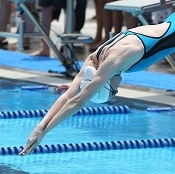Body position in freestyle (or the front crawl) is something simple but often overlooked. Having proper body position though can greatly reduce the resistance of the water as you move through it, making you faster.
Related article: The Beginner’s Guide to Swimming Freestyle
It’s also one way to help reduce injuries when you’re swimming, as incorrect body position can put unnecessary strain on your muscles.
While short, here’s a quick guide to the correct body position in freestyle.
Disclosure: This post may contain affiliate links, meaning we earn a small commission at no cost to you if you purchase something through one of our links. As an Amazon Associate, we earn from qualifying purchases. Please check out our disclosure page for more information

Body Position in Freestyle
In the front crawl, or freestyle stroke, your body is in a horizontal position in the water and the front of your body faces the bottom of the pool.
This includes your head, which also faces toward the bottom of the pool. Except when it’s turning to breathe. This means that it shouldn’t be lifted or tilted down too much. Which we’ll cover next!
Your body should also be on top of the water when you’re swimming freestyle. It may seem obvious to say this but some swimmers try to dive their body into the water as they’re swimming.
More Content for You: 7 Best Waterproof MP3 Players for Swimming
Swimmers may also dip below the water if they have incorrect technique during their stroke or kick pieces of the freestyle stroke.
Whether due to pushing yourself under the water as you swim or incorrect technique, this is an exhausting way to swim freestyle. It increases the resistance of your body moving through the water, which can make swimming much more difficult.
Instead, you should try to keep your body as close to the surface of the water as you can. While your arms and legs will dip below down into the water for the stroke and kick, these are temporary instances.
Proper body position in freestyle is important to keep yourself balanced, reduce drag, swim faster, and help prevent injury.
Head Position in Freestyle
In freestyle, your head faces down except when you turn to breathe. However, there’s a balance you need to find in how much your head faces down.
If you press it too deeply, then you’re catching water on your head and shoulders. But if you’re lifting your head while swimming, you’re still creating drag and forcing your body position out of balance. And both positions can hurt or strain your neck.
Related article: 7 Common Freestyle Stroke Mistakes
Instead, it should remain in a neutral position. As it would when you’re standing still and looking straight ahead.
This puts the water level not quite at the top of your head but a bit further down instead. About halfway between your cap and the top of your head.
Too Deep
While it’s suggested that you look straight down at the pool, we believe this puts your head too deep in the water.
If the water level is hitting the top of your head and/or the water is going over your head, it’s too deep. Not only does this put pressure on your neck and shoulders, but it also makes you dive into the water as you’re swimming.
Tilt your head up just enough so the water level is hitting closer to your forehead but not right at your forehead. This angle keeps you from burying your head when you swim and from lifting it too much.
More Content for You: Can You Swim with Bad Eyesight?
It’s also at just the right angle that you can see more in front of you if you look up with your eyes. You won’t be able to see everything in front of you unless you lift your head completely. But you can see more than if you looked straight down.
Lastly, remember that you need to tilt, not lift your head. Just as you should be tilting your head, not arching your neck.
Head Position Tilted Up
Except for drill work and checking for obstacles in front of you, you shouldn’t be swimming with your head tilted up. This puts an incredible amount of stress on your neck muscles.
Swimming with your head up also forces your hips to sink and disrupts your body’s balance in the water. This in turn creates more resistance and makes it harder to swim.
Instead, tilt your head down some (or tuck your chin, if this description helps) so the water level is between your forehead and the top of your head.
More Content for You: How to Fix Common Swim Goggle Problems
Doing this will help keep your hips higher in the water so you’re better balanced and reduce the resistance in the water as you swim. It will also reduce the strain on the muscles in your neck
One thing we will note is to ensure you’re not tilting your head up and then rotating it to breathe. Your head should stay in a neutral position even when you’re going to breathe.
Rotation of the Body
While the body position in freestyle is horizontal in the water, that doesn’t mean that it’s flat. During freestyle, your body rotates slightly from side to side. Especially when you’re turning your head to breathe.
We emphasize the word ‘slightly’ because you shouldn’t be rotating so much that your body is completely on its side. Doing this wastes excess energy trying to rebalance the body and roll back into the water.
Instead, it’s a small rotation of your hips and body. One that isn’t overly noticeable from above the water unless you’re looking for it. However, underneath the water, you can see swimmers rotate their hips as they’re swimming.
Related article: 10 Drills to Help You Master the Freestyle Stroke
The rotation of your body in freestyle starts with the core and hips, and the rest of your body will follow naturally. As your hips are rotating, they’re helping elongate your arms so you can roll into your stroke easier. At the same time, your kick is helping to finish driving the rotation of the body.
At no point (or very little time) should your hips be pointing directly down at the bottom of the pool. They should be rotating in time with each stroke you take and tying into the stroke itself.
Body Position When Side Breathing
When you’re side breathing in freestyle, your body position remains the same. High in the water, balanced, head still neutral, and most importantly, rotating.
Again, you shouldn’t be tilting your head up before you side-breathe. And you also shouldn’t be lifting it and raising it out of the water.
Related article: How to Side Breathe When Swimming Freestyle
Instead, let your head naturally roll to the side with your stroke. This is where the rotation of your body in freestyle is so important as it makes it easier to breathe.
It should almost be as though you’re turning your head to look at someone standing next to you. Where your head is keeping the neutral position instead of tilting up and then rolling to the side to breathe.
For more information about side breathing in freestyle, check out our other article 7 Drills to Practice Side Breathing in Freestyle
In Closing
When it comes to body position in freestyle, the key is to remember that your body should be high in the water and on top of it.
To make swimming easier, keep your head in a relaxed, neutral position, and allow your body to rotate naturally. All of these together will make it easier to swim freestyle.
As always, happy swimming!
Chevron
Bonus Content
How to Count Laps in Swimming: Knowing how to count laps in swimming can make the difference between hitting your swimming goal and missing it.
6 Best Gear Bags for Swimmers: Gear bags are a staple for most swimmers, as they provide a place to hold wet items. Here are the 6 best mesh gear bags for you.

Want to Improve at the Pool?
Join swimmers and swim parents to receive my free newsletter and receive a free Swimming Glossary e-book as a thanks!
Every month you’ll receive tips and coaching to help you find success at the pool.
About

Chevron is a current competitive swimmer with almost 20 years of experience in the pool. And although she fell into the sport by accident in her high school years, she still trains daily and competes throughout the year. She’s committed to providing guidance to all levels of swimmers and believes that everyone should know how to swim.